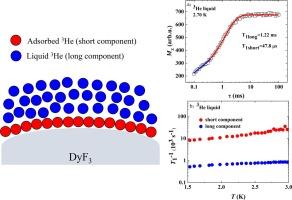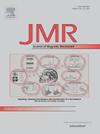接触 20 纳米 DyF3 纳米粒子的氦-3 核磁弛豫机制研究
IF 2
3区 化学
Q3 BIOCHEMICAL RESEARCH METHODS
引用次数: 0
摘要
在温度为 1.5-4.2 K、磁场高达 505 mT 的条件下,利用脉冲核磁共振(NMR)研究了吸附和液态 3He 与 20 纳米 LaF3(99.67%)和 DyF3(0.33%)粉末混合物接触时的自旋动力学。实验中观察到了双分量核磁弛豫现象,并提出了理论弛豫模型。该模型考虑了位于吸附层和液体主体中的氦-3 核的磁化交换,可以解释这种现象。提出的弛豫模型可应用于受吸附层影响较大的其他系统。本文章由计算机程序翻译,如有差异,请以英文原文为准。

A study of helium-3 nuclear magnetic relaxation mechanism in contact with 20 nm DyF3 nanoparticles
The spin kinetics of adsorbed and liquid 3He in contact with a mixture of LaF3 (99.67 %) and DyF3 (0.33 %) 20 nm powders at temperatures of 1.5–4.2 K in magnetic fields up to 505 mT was studied by pulsed nuclear magnetic resonance (NMR). Two-component of nuclear magnetic relaxation was observed in the experiment and theoretical relaxation model was proposed. The possible explanation of this phenomena can be carried out by a model that consider the exchange of magnetization of helium-3 nuclei located in the adsorbed layer and in the bulk of the liquid. The proposed relaxation model can be applied to other systems with the strong influence of adsorbed layer.
求助全文
通过发布文献求助,成功后即可免费获取论文全文。
去求助
来源期刊
CiteScore
3.80
自引率
13.60%
发文量
150
审稿时长
69 days
期刊介绍:
The Journal of Magnetic Resonance presents original technical and scientific papers in all aspects of magnetic resonance, including nuclear magnetic resonance spectroscopy (NMR) of solids and liquids, electron spin/paramagnetic resonance (EPR), in vivo magnetic resonance imaging (MRI) and spectroscopy (MRS), nuclear quadrupole resonance (NQR) and magnetic resonance phenomena at nearly zero fields or in combination with optics. The Journal''s main aims include deepening the physical principles underlying all these spectroscopies, publishing significant theoretical and experimental results leading to spectral and spatial progress in these areas, and opening new MR-based applications in chemistry, biology and medicine. The Journal also seeks descriptions of novel apparatuses, new experimental protocols, and new procedures of data analysis and interpretation - including computational and quantum-mechanical methods - capable of advancing MR spectroscopy and imaging.

 求助内容:
求助内容: 应助结果提醒方式:
应助结果提醒方式:


